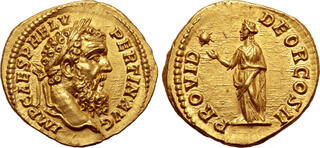| Roma Numismatics Ltd > Auction XXX | Auction date: 21 March 2024 |
| Lot number: 464 Price realized: 50,000 GBP (Approx. 63,339 USD / 58,316 EUR) Note: Prices do not include buyer's fees. | Show similar lots on CoinArchives Find similar lots in upcoming auctions on |
| Lot description: Pertinax AV Aureus. Rome, AD 193. IMP CAES P HELV PERTIN AVG, laureate head to right / PROVID DEOR COS II, Providentia standing to left, holding out hand to star in left field. RIC IV 11a; Lempereur Type 10, 146 (D36/R88); C. 42; BMCRE 11; Calicó 2389a. 7.22g, 21mm, 12h. Fleur De Coin; lustrous metal, a powerful and sharply engraved portrait. Acquired from Classical Numismatic Group (inventory no. 595027, USD 85,000). Pertinax was the first Emperor in the tumultuous 'Year of Five Emperors'. His early life and career is well documented in the Historia Augusta: born into a humble family and the son of a freedman, Pertinax had originally tried to make his way in life as a teacher of grammar, but at some point decided to try to attain a greater station, and with the help of a patron he was commissioned an officer in the Roman army. Pertinax distinguished himself in a campaign against Parthia, and after postings in Britain and on the Danube he served as procurator in Dacia. His career suffered a serious setback during the reign of Marcus Aurelius on account of court intrigues, however he was recalled to assist Claudius Pompeianus during the Marcomannic Wars. In 175 he was made suffect consul, and he then served as governor of a string of provinces including Syria and Britain. In the 180s he was sent to Britain where the army was in a state of mutiny. His attempt to calm the restive soldiers resulted in his bodyguard being attacked, and Pertinax was left for dead. After his recovery he severely punished the mutinous legion, adding to his reputation as a disciplinarian. In 187 he was forced to resign due to the legions having grown hostile to his strict command style. His career reached an apex when he was given the proconsulship of Africa, the urban prefecture of Rome, and a second consulship with the emperor as his colleague. When Commodus was murdered on the last day of AD 192, Pertinax was still serving as urban prefect, and hurried to the Praetorian camp where he was proclaimed emperor the following morning. His attempts at reform and restraint, along with attempts to impose discipline on the unruly Praetorians, did not endear him to the Guard who had expected a large donative. After a reign of only three months, during which time he refused imperial titles for his wife and son, a contingent of several hundred Praetorian Guardsmen rushed the palace and Pertinax, although he almost succeeded in reasoning with them, was struck down. Yet by his understanding of the danger of his station and his wise decision not to associate his family with the purple, they were spared from violence. The powerful portrait of this magnificent aureus shows the furrowed brow and weathered face of a man who had attained high position through hard work and discipline, now burdened by the cares of state. It is an appropriate depiction for an emperor who tried hard to bring the unravelling Roman system back onto the correct path but was ultimately slain for his efforts. Estimate: 45000 GBP |  |


